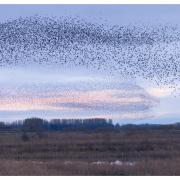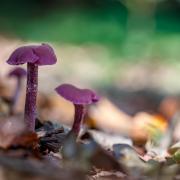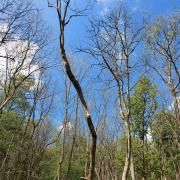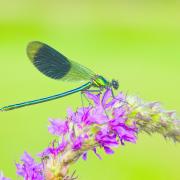Autumn means fallen leaves, flamboyant colours, fresh cool air – and fungi!

Woodland walks are a joy in any season. Carpets of bluebells in spring, blissful cool shade and birdsong in summer, glistening spiders’ webs and sleepy silence in winter… but an autumn woodland is something particularly special. Few landscapes in Yorkshire can boast such a dazzling array of colour than a woodland - the golden yellow of the field maple, the bronze of the common beech, the fiery orange of the oak, the warm red of the rowan. This rich landscape of warm colours brings life back into a chilly scene, and makes for a memorable autumn wander.
And it’s not just trees that reveal bursts of colour in a woodland. Get a little closer and you’ll see flashes of white, yellow, purple and red clustered around the base of living trees or lining trunks of dead ones on the woodland floor – fabulous fungi! Well, more likely what you will see on the surface is a mushroom or toadstool. The fruiting body of the fungus is called the mushroom (sometimes called toadstool, usually when referring to poisonous mushrooms), whereas the entire organism – including the roots we can’t see – is called the fungus.
Trees and fungi have a very important relationship, in which they both support each other and, in turn, the long-term health of the woodland. Fungi feed on the decaying plant matter that litters the woodland floors in autumn, and help recycle that nutrients back into the soil to aid tree growth. Fungi also provides food for a wide variety of insects, from tiny beetles to large slugs; these insects are then eaten by other wildlife like hedgehogs, squirrels and all sorts of woodland birds.
There are two main groups of fungi: spore droppers and spore shooters. Spore droppers (basidiomycetes) generally have gills or tubes underneath where they let their spores fall to the ground to be carried by the wind. They are more likely to be a typical mushroom shape like the fly agaric and blackening waxcap. Spore shooters (ascomycetes) on the other hand – you guessed it – release their spores by shooting them into the air, like the pointy candlesnuff fungus.

Why not venture on a ‘fungi foray’ in a woodland this autumn, and see how many magical mushrooms you can spot? Yorkshire Wildlife Trust has many beautiful woodland nature reserves perfect for finding fungi, such as Low Wood in Keighley, Moorlands in York and Grass Wood in Grassington.
Use these illustrations to help identify some of Yorkshire’s most common fungi and where to find them.
If you are visiting a Yorkshire Wildlife Trust nature reserve this autumn, please do so safely; consider the wildlife and each other, and adhere to any coronavirus-related measures in place (including social distancing). And remember, many common UK fungi – including several listed here – are poisonous, so please do not touch or eat any. Besides, a pretty picture lasts a lot longer!

• Fly agaric – this beautiful fairy-tale mushroom may look as pretty as a fairy toadstool, but it’s actually poisonous – so look but don’t touch!
• Common puffball – this cute little mushroom is also known as the warted puffball, gem-studded puffball, wolf farts and the devil’s snuff-box!
• Jelly ear – as the name suggests, these strange fungi look like little ears growing on decaying branches. They’re popular in Chinese cuisine where they’re referred to as ‘wood ear’ mushrooms.
• Ochre brittlegill – this lovely yellow fungus is just one from the rainbow brittlegill family; you can see brittlegills in a variety of colours from bright yellow to red and burgundy.

• Blackening waxcap – also known as the witch’s hat due to its conical shape, this fungus is a colourful species that grows in grassland and turns black with age.
• Artist’s bracket - these large flat fungi are common on dead trees, and are so named as they are used by artists to draw on like a natural canvas!
• Brown birch bolete - as the name suggests this fungus is often found growing on or around birch trees. It is edible, but take extreme caution and only forage with a trained professional’s supervision.
• Honey fungus – this fungus is much maligned by gardeners, as it is associated with killing trees. However, it actually performs an important job in woodlands by killing off weak trees and creating deadwood – a vital habitat for insects and other fungi.

• Brown rollrim – this delicate mushroom is named after its distinctive rolled rim. Though it was regularly eaten up until the Second World War, it is now considered toxic so look but don’t touch!
• Scarlet elf cup - this is a small species, that can be easily overlooked; but its bright red colour means that if you are looking it can be found in most places.



























